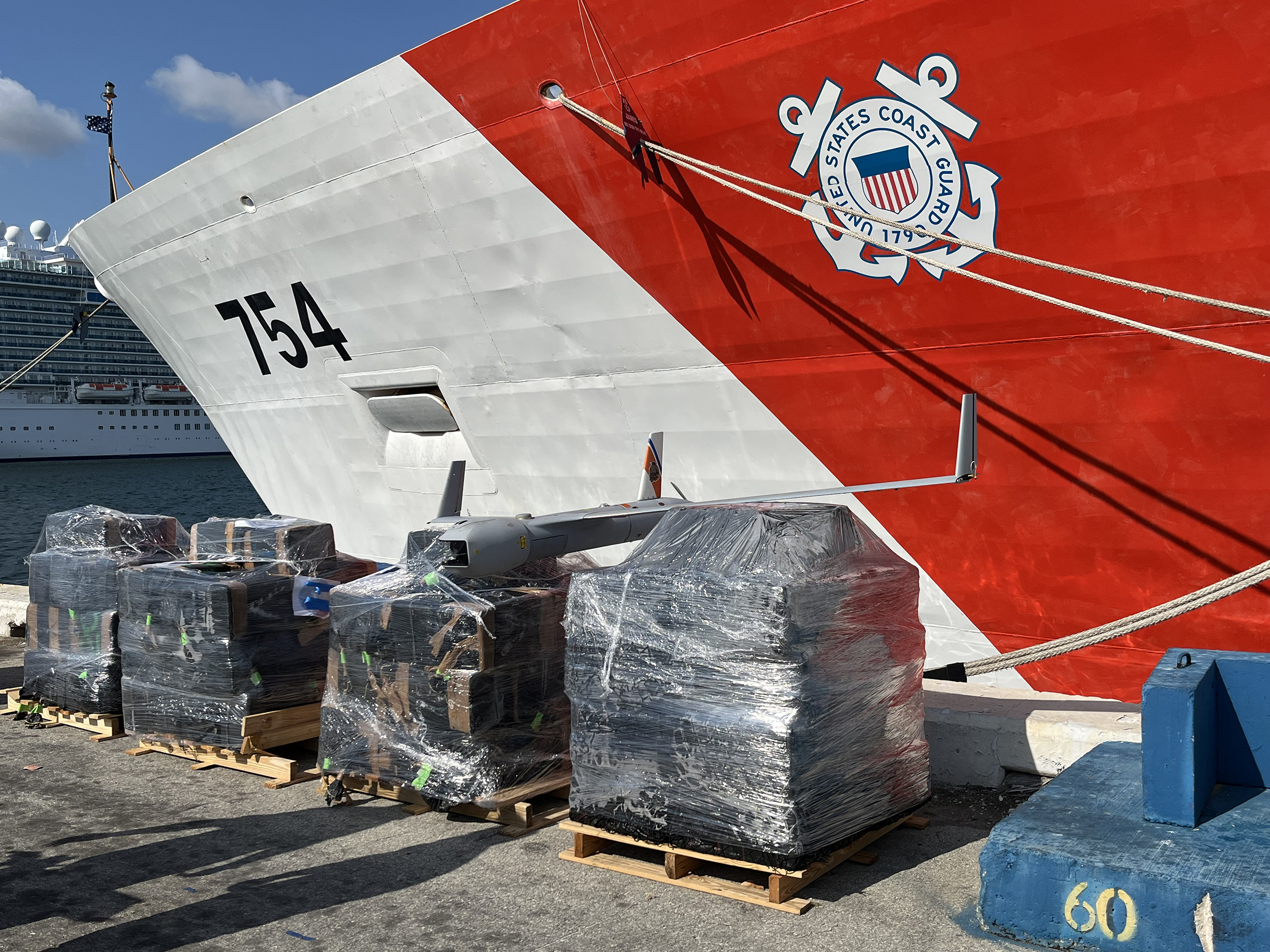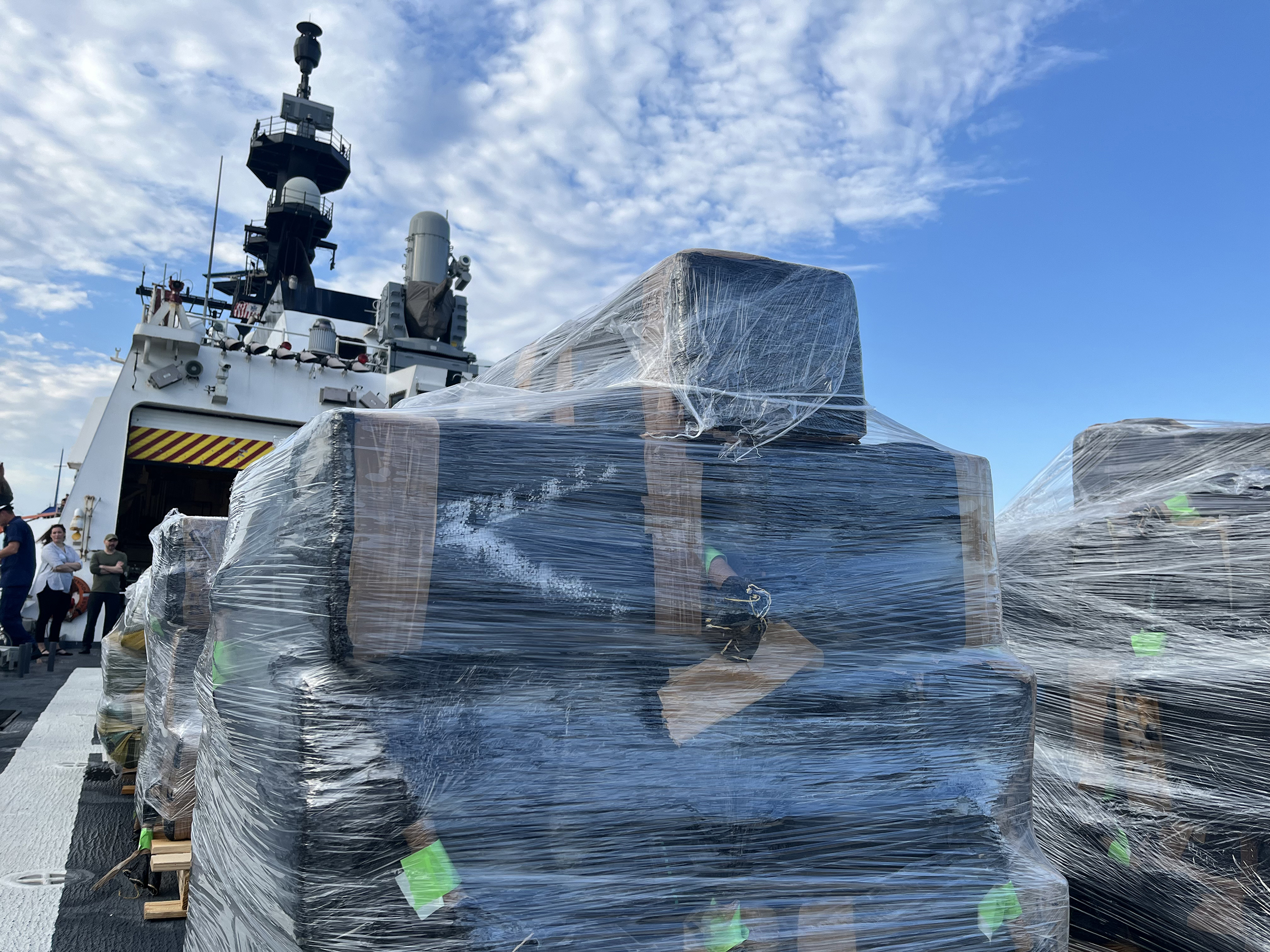Panama Express Strike Force interdicts nearly $510 million in illegal narcotics in Eastern Pacific Ocean
MIAMI – The Organized Crime Drug Enforcement Task Forces interdicted and announced the seizure of more than 44,550 pounds of cocaine and 3,880 pounds marijuana valued at approximately $509.9 million as part of the joint multiagency Panama Express Strike Force mission in the Eastern Pacific Ocean.
The PANEX mission is a prosecutor-led, intelligence-driven, multiagency approach to disrupt and dismantle transnational criminal organizations involved in large scale drug trafficking, money laundering, and related activities with U.S. Immigration and Customs Enforcement, alongside the U.S. Coast Guard Investigative Service, the Drug Enforcement Administration, FBI and the U.S. Attorney for the Middle District of Florida.
This patrol resulted in 11 interdictions and the detainment of 34 suspected narco-traffickers who were transferred ashore to face federal prosecution. These interdictions are tied to criminal investigations by federal partners and have been linked to transnational criminal and foreign terrorist organizations including the Clan del Golfo, Sinaloa Cartel, and Cartel Jalisco Nueva Generacion.
These PANEX Strike Force interdictions deny these sophisticated criminal organizations more than half a billion dollars in illicit revenue. They provide critical testimonial and drug evidence as well as key intelligence for their total elimination.
Interdictions in the Eastern Pacific Ocean are performed by members of the U.S. Coast Guard under the authority and control of the Eleventh Coast Guard District, headquartered in Alameda, Calif. Once the seized narcotics and suspects are ashore, the investigations into the origins of the narcotics and innerworkings of the transnational criminal organizations are conducted by ICE HSI, DEA, and FBI. The U.S. Attorney’s office charges and prosecutes the suspected narco-traffickers.
The U.S. Coast Guard Cutter Mohawk, U.S. Coast Guard Helicopter Interdiction Tactical Squadron Jacksonville, U.S. Coast Guard Tactical Law Enforcement Team-Pacific, U.S. Customs and Border Protection, Air and Marine Operations) aircrews, Joint Interagency Task Force-South assisted PANEX and the Coast Guard Cutter James during interdiction operations.
The interdictions were:
- On Jan. 5, the CGC James’ unmanned aircraft system (drone) spotted a suspicious vessel in international waters approximately 260 miles off the coast of Ecuador. The cutter’s boarding team interdicted the vessel, apprehended three suspected smugglers and seized over 2,025 pounds of cocaine.
- On Jan. 6, a maritime patrol aircraft spotted three suspicious go-fast vessels headed in the same direction approximately 280 miles off the coast of Ecuador. James simultaneously intercepted the three go-fast vessels, with the help from a drone and Coast Guard Helicopter Interdiction Tactical Squadron (HITRON) aircrew, James’ boarding teams interdicted the vessels, apprehended nine suspected narco-traffickers and seized over 13,960 pounds of cocaine.
- On Jan. 7, a maritime patrol aircraft detected a suspicious low-profile go-fast vessel in international waters, approximately 330 miles southeast of the Galapagos Islands, Ecuador. James’ embarked HITRON employed airborne use of force tactics to compel the non-compliant vessel to stop, and the boarding team apprehended three suspected narco-traffickers and seized over 8,240 pounds of cocaine.
- On Jan. 11, a U.S. Customs and Border Protection – Air and Marine Operations aircrew detected a suspicious go-fast vessel approximately 275 miles southwest of Ecuador. James’ boat crew and Coast Guard Cutter Stone’s helicopter aircrews interdicted the go-fast vessel, apprehended three suspected narco-traffickers and seized over 3,385 pounds of cocaine.
- On Jan. 18, Coast Guard Cutter Mohawk’s crew detected a suspicious go-fast vessel, approximately 185 miles west of Ecuador. After the suspected smugglers jettisoned the presumptive narcotics into the water, James’ small boat chased down the fleeing go-fast vessel from 60 nautical miles away while Mohawk’s crew recovered the jettisoned bales. James’ boarding teams interdicted the go-fast vessel and apprehended three suspected narco-traffickers, seizing approximately 5,950 pounds of cocaine.
- On Jan. 30, James’ drones detected multiple suspicious go-fast vessels approximately 380 miles west off the coast of Peru. James’ boarding team employed surface use of force tactics to interdict the go-fast vessel, apprehended three suspected narco-traffickers and seized over 3,870 pounds of cocaine.
- On Feb 1, James’ drones spotted a suspicious go-fast vessel operating approximately 280 miles off Ecuador. James’ boarding team interdicted the vessel, apprehended three suspected narco-traffickers and seized over 3,630 pounds of cocaine.
- On Feb. 3, James’ drones detected multiple suspicious go-fast vessels operating 215 miles off Peru. James’ boarding team interdicted the vessel, apprehended three suspected narco-traffickers and seized nearly 3,490 pounds of cocaine.
- On Feb. 15, a CBP-AMO aircrew spotted a suspicious go-fast vessel, operating 260 miles off Costa Rica. James’ helicopter interdiction aircrew employed airborne use of force tactics to compel the non-compliant vessel stop. James’ boarding team interdicted the vessel, apprehended four suspected narco-traffickers and seized nearly 3,880 pounds of marijuana.
PANEX continues increased operations to interdict, seize, and disrupt transnational shipments of cocaine, marijuana, and other bulk illicit drugs by sea. These drugs fuel and enable cartels and transnational criminal organizations to produce and traffic illegal fentanyl, posing a significant threat to the safety of the United States.



